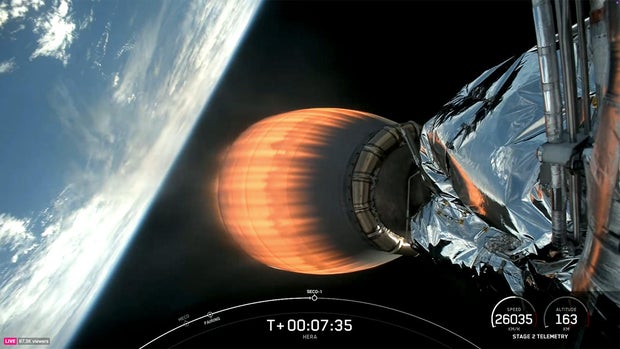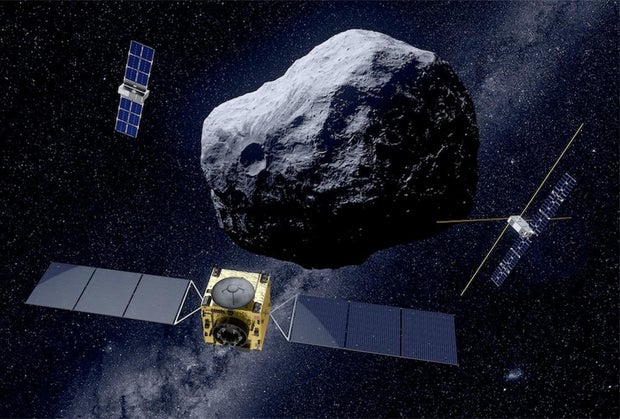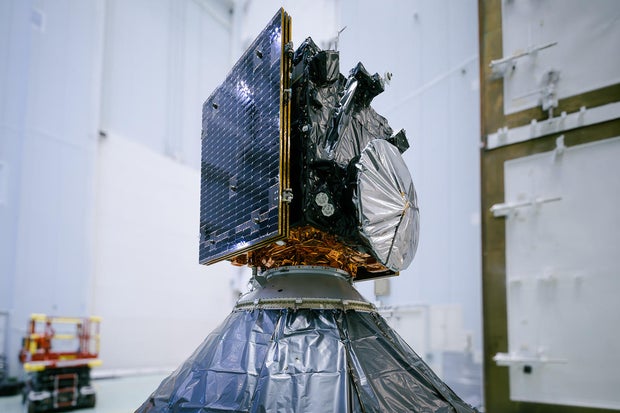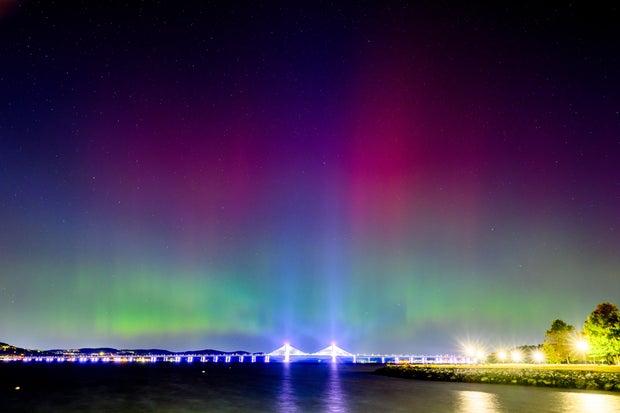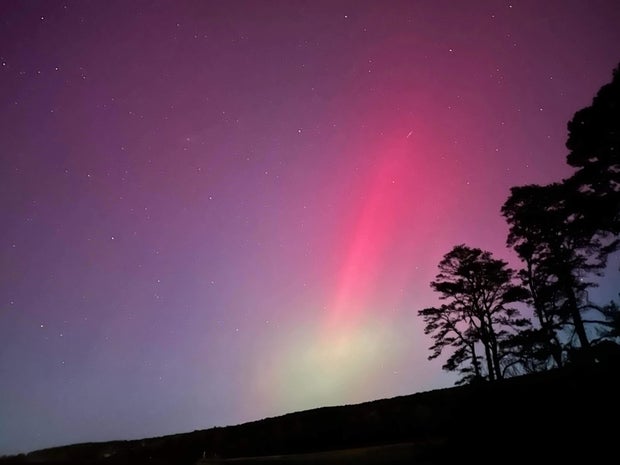CBS News
SpaceX launches European asteroid probe as hurricane weather closes in

Dodging stormy weather ahead of Hurricane Milton, SpaceX launched the European Space Agency’s $398 million Hera probe Monday on a follow-up flight to find out precisely how a moonlet orbiting a small asteroid was affected by the high-speed impact of NASA’s DART probe in 2022.
The launching was in doubt until the last moment, with thick clouds and rain across Florida’s Space Coast, fueled by moisture pulled in by the intensifying hurricane to the west.
SpaceX
But as the launch time approached, conditions improved enough to satisfy launch safety rules and NASA managers cleared the rocket for takeoff. Right on time, at 10:52 a.m. EDT, the Falcon 9’s first stage engines ignited with a burst of flame and the booster climbed smoothly away from the Cape Canaveral Space Force Station.
Liftoff came in the nick of time for several hundred European Space Agency managers, scientists, engineers and journalists who flew to Florida to watch the launch.
SpaceX
Hurricane Milton is expected to bring extreme winds and torrential rain to Florida’s Space Coast by Wednesday, a forecast that prompted NASA to stand down on plans to launch the agency’s $5.2 billion Europa mission to Jupiter and its ice-covered moon Europa on Thursday.
Instead, NASA announced late Sunday the rocket and it costly payload will remain in a SpaceX hangar at the base of launch pad 39A at the Kennedy Space Center until Milton passes by and safety personnel have a chance to inspect spaceport facilities for signs of damage.
The weather also has thrown a wrench into NASA’s plans to bring three NASA astronauts and a Russian cosmonaut back to Earth after a 217-day stay aboard the International Space Station.
Crew 8 commander Matthew Dominick, Mike Barratt, Jeanette Epps and cosmonaut Alexander Grebenkin had planned to undock Monday.
But NASA announced Sunday their departure would be delayed to at least Thursday because of the expected bad weather. Crew Dragon ferry ships require calm winds and seas in the Gulf of Mexico or the Atlantic Ocean to permit a safe splashdown.
Mission to an asteroid and its moon
In the meantime, despite an initially grim forecast, SpaceX was able to take advantage of a break in the weather to kick off Hera’s two-year voyage to the asteroid Didymos and its small moon Dimorphos.
ESA
The DART impact altered the 11-hour 55-minute orbit of the 495-foot-wide Dimorphos, shaving 31 minutes off the time needed to complete one trip around the parent asteroid Didymos. The test confirmed the feasibility of someday nudging a threatening asteroid off course before a possibly devastating Earth impact.
But a successful deflection would depend on a variety of factors, including when the threat was detected — the farther out, the better — and the asteroid’s composition.
ESA’s Hera probe will orbit the Didymos system and study both asteroids in detail with 11 high-tech cameras and other instruments, deploying two small “cubesat” satellites to study the interior structure of Dimorphos, assess the DART impact crater, the moon’s internal structure and composition.
The goal of the Asteroid Impact and Deflection Assessment, or AIDA, is to better understand the techniques that might be needed to prevent an Earth impact.
“The good news is no dinosaur killer is on its way to Earth during the next 100 years,” said Richard Moissl, director of ESA’s Planetary Defense Office. “We are safe from that scenario, but there are smaller ones, especially in this dangerous size, 50 meters and upwards, where it really threatens human life on the ground.”
ESA
The first step in planetary defense is detection, he said, followed by detailed observations to pin down the asteroid’s orbit and determine whether a collision with Earth is a possibility.
“For small objects, civil protection is the way to go,” he said. “But 50 meters (160 feet across) and larger, you really want this thing not to hit Earth, not to threaten population centers. And then step three comes into play, deflection.
“But again, it’s always good to know what you’re up against. And this is where Hera and DART come into play.”
Unlike most Falcon 9 flights, there were no plans to recover the rocket’s first stage. To give Hera the velocity need to break free of Earth gravity, the Falcon 9’s two stages were programmed to use up all of their propellants, leaving none in reserve for a powered first stage landing.
The flight plan called for two firings of the upper stage engine before Hera’s release to fly on its own one hour and 16 minutes after liftoff.
To reach Didymos and Dimorphos, Hera will have to execute a deep space thruster firing in November to set up a gravity-assist flyby of Mars in March, sailing within about 3,700 miles of the red planet. Along the way, the spacecraft will pass within 620 miles of the small martian moon Deimos.
“By swinging through the gravitational field of Mars in its direction of movement, the spacecraft gains added velocity for its onward journey,” Michael Kueppers, ESA’s project scientist, said on the agency’s website.
“This close encounter is not part of Hera’s core mission, but we will have several of our science instruments activated anyway. It gives us another chance to calibrate our instruments and potentially to make some scientific discoveries.”
After another deep space maneuver in February 2026, Hera will finally be on course to slip into orbit around Didymos the following October. The mission is expected to last about six months.
CBS News
Biden urging Congress to return from recess to approve hurricane disaster relief funds

Watch CBS News
Be the first to know
Get browser notifications for breaking news, live events, and exclusive reporting.
CBS News
Northern lights forecast maps for tonight show best areas in U.S. to see aurora borealis

The northern lights made an incredible display over much of the United States on Thursday — and might make a return appearance Friday night.
The aurora borealis was visible as far south as Florida on Thursday. Photos show the sky lit up in red and purple, even in some brightly-lit areas like New York City and Chicago.
The strong geomagnetic storm that created such a show has subsided, according the National Oceanic and Atmospheric Administration, but some parts of the U.S. may again see the northern lights tonight. Here’s what to know.
Roy Rochlin / Getty Images
Where will the northern lights be visible tonight?
The northern lights will be visible for parts of the northern U.S., according to the NOAA Space Weather Prediction Center’s aurora forecast. The aurora will be visible over much of Canada and Alaska, but the northern lights can also be seen from as far as 620 miles away if the conditions are right, NOAA says.
Parts of Idaho, South Dakota, Minnesota and Wisconsin may be able to see the lights Friday night. On the East Coast, the aurora might be visible in northern New York and parts of Vermont and New Hampshire. Areas of Maine may also see the northern lights.
The lights will appear to the north when it’s dark outside. If you can’t see them with the naked eye, they may be visible through a phone camera or other device.
NOAA Space Weather Prediction Center
What time will the northern lights be most visible?
The northern lights are most visible just after sunset or just before sunrise, NOAA said. The aurora is not visible during the day. Dark, cloudless skies with little artificial light provide the best viewing experience.
Ross Harried/NurPhoto via Getty Images
Why have the northern lights been so visible lately?
Over the last several months the sun has been incredibly active, unleashing a series of coronal mass ejections from its surface, CBS Boston reported. That’s resulted in multiple visible aurora shows.
The geomagnetic storm responsible for Thursday’s stunning skies is now subsiding, CBS Boston reported. That means there will be less chance of seeing the aurora on Friday, but there may be more opportunities in the future.
Shawn Dahl, a forecast coordinator with the Space Weather Prediction Center, told CBS Boston that the northern lights have been so intense lately because of where the sun is in its 11-year solar cycle. Dahl said that “we are in the midst of solar maximum.”
Heather Kepple
“What that means is the sun is now this twisted-up mass of strong magnetic fields, and some of these are so localized and intense they reveal themselves as these sunspot groups,” Dahl said. “That’s the source of a bunch of the space weather storms that we’re looking for and predict.”
What causes the northern lights?
The northern lights are caused by interactions between the sun’s solar winds and the Earth’s protective magnetic field, according to NOAA. Those two phenomenons result in geomagnetic storms and increased geomagnetic activity.
The higher the geomagnetic activity is, the better your odds are of seeing the aurora. Increased geomagnetic activity means the aurora will become brighter, more active and visible farther from the poles of the planet, NOAA said.
Even moderate solar wind creates the aurora, NOAA said, so there is usually a weak aurora visible from somewhere on Earth. The best places to see these weaker auroras is close to the planet’s poles, like in Greenland or southern Argentina. If you see the aurora near the North Pole, it’s nicknamed the northern lights. The same phenomenon near the South Pole is called the southern lights.
CBS News
14 best high-yield savings accounts to open this October

Getty Images
After years of stubbornly high rates, the wider interest rate environment is shifting. The Fed issued a 50-basis-point cut to the benchmark rate in late September, which led rates on everything from mortgages to home equity loans to drop in tandem, alleviating some of the heavy burden that’s been weighing on borrowers recently. But while the climate of dropping rates may benefit borrowers, it isn’t nearly as beneficial for savers, as rates on deposit accounts typically fall alongside rates on loans and other borrowing products.
That said, there is still a great opportunity for savers to maximize their returns right now by putting some of their savings into a high-yield savings account. Even in today’s shifting rate landscape, many high-yield accounts continue to offer higher-than-average rates, and unlike certificate of deposit accounts (CDs), which generally require you to keep your money locked away until maturity, a high-yield savings account offers the opportunity to earn a great rate and maintain easy access to your funds.
While the rates on high-yield savings accounts are variable, meaning that they can change over time, many currently offer annual percentage yields (APYs) comparable to or even exceeding those of CDs, without you having to sacrifice liquidity. So for those seeking a balance between competitive rates and financial flexibility, exploring these high-yield savings options could be a smart move in today’s market.
See how much more you could earn with one of the best high-yield savings accounts now.
14 best high-yield savings accounts to open this October
The following high-yield savings accounts could be a good bet if you want to maximize the returns on your money this October:
- Pibank — 5.50%: There is no minimum deposit requirement to open this account; there is no minimum balance required to earn the stated APY; this account does not charge a monthly service charge
- TIMBR — 5.25%: There is a $1,000 minimum deposit requirement to open this account; there is no minimum balance required to earn the stated APY; this account does not charge a monthly service charge
- BrioDirect — 5.15%: There is a $5,000 minimum deposit requirement to open this account; there is a $25 minimum balance required to earn the stated APY; this account does not charge a monthly service charge
- CloudBank 24/7 — 5.15%: There is a $1 minimum deposit requirement to open this account; there is a$1 minimum balance required to earn the stated APY; this account does not charge a monthly service charge
- RBMAX — 5.15%: There is a $10 minimum deposit requirement to open this account; there is no minimum balance required to earn the stated APY; this account does not charge a monthly service charge
- Elevault — 5.13%: There is no minimum deposit requirement to open this account; there is no minimum balance required to earn the stated APY; this account does not charge a monthly service charge
- Bask Bank — 5.10%: There is no minimum deposit requirement to open this account; there is no minimum balance required to earn the stated APY; this account does not charge a monthly service charge
- EverBank — 5.05%: There is no minimum deposit requirement to open this account; there is no minimum balance required to earn the stated APY; this account does not charge a monthly service charge
- Jenius Bank — 5.05%: There is no minimum deposit requirement to open this account; there is no minimum balance required to earn the stated APY; this account does not charge a monthly service charge
- Flagstar Bank — 5.00%: There is a $1 minimum deposit requirement to open this account; there is a $25,000 minimum balance required to earn the stated APY; this account charges a $15 monthly service charge (which is waived with a $10,000 average balance)
- Ivy Bank — 5.00%: There is a $2,500 minimum deposit requirement to open this account; there is a $2,500 minimum balance required to earn the stated APY; this account does not charge a monthly service charge
- Laurel Road — 5.00%: There is no minimum deposit requirement to open this account; there is a $5,000 minimum balance required to earn the stated APY; this account does not charge a monthly service charge
- Bread Savings — 4.95%: There is a $100 minimum deposit requirement to open this account; there is a $100 minimum balance required to earn the stated APY; this account does not charge a monthly service charge
- First Foundation Bank — 4.90%: There is a $1,000 minimum deposit requirement to open this account; there is no minimum balance required to earn the stated APY; this account does not charge a monthly service charge
Explore the top savings rates available to you here.
The bottom line
In today’s changing rate environment, high-yield savings accounts remain a standout option for savvy savers who want to earn a high APY on their money while maintaining access to the funds in their accounts. These accounts provide significantly higher APYs compared to traditional savings accounts, with some reaching up to 5.5% currently. This makes them an attractive choice for emergency funds and short-term savings goals. By choosing the right high-yield savings account, savers can potentially earn hundreds or even thousands of dollars more in interest compared to traditional savings options.



